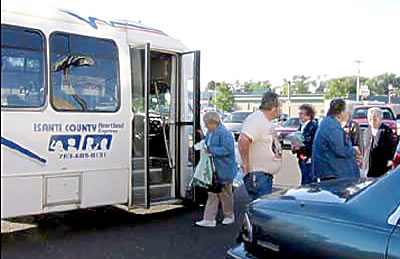|
By Craig Wilkins

Cambridge area residents celebrate the city’s purchase of a new city transit bus in 2006. Photo from the 2006 Minnesota Transit Report |
With an assist from Mn/DOT, the transit system that serves Chisago and Isanti counties revamped its operations to improve service and increase options for system users.
The Office of Transit’s operational review that urged service design changes and Cambridge’s purchase of a bus for local transit, provided the momentum to improve the system’s operation.
Jackie Forner, director of the Chisago-Isanti Heartland Express, said there were other considerations involved as well, including recognition by elected officials and other community leaders that changes were needed to improve transit service.
The transit system now operates 11 buses and uses scheduled flexible routes and designated bus stops and transfer points. Dial-a-ride service, the previous standard, is still available in the less-populated areas of both counties.
The revamped service started in June.
Sue Siemers, District 3 transit manager, said the changes reflect expanding development and increasing transit demand in the region.
The area includes two hospitals, several large retail centers and restaurants and other businesses that employ lower-paid workers who are more likely to use transit facilities.
There are also increasing numbers of commuters who drive to a transfer point and complete their trips by bus.
Siemers said, for example, a Braham resident who wants to reach the new hospital in Wyoming can take the north-south bus to Cambridge, and then transfer to the east-west route to reach Wyoming. That allows the north-south bus to make more runs and serve additional riders.
Service such as this was not feasible with the old system, Siemers said, because of the length of the route and the amount of time drivers spent “dead-heading,” that is, returning from a destination without passengers.
Sarah Lenz, a program administrator with the Office of Transit, said many people liked the “high-touch, door-to-door service,” but agreed the service needed to improve its performance.
The change in service brings excitement for Forner and other Heartland Express staff members who are anxious to improve service and mobility in the region.
“We expect continual improvements in productivity and reduced trip times for riders,” Forner said. “And it’s really great to have a printed schedule to hand out when we’re promoting the new service.”
|



